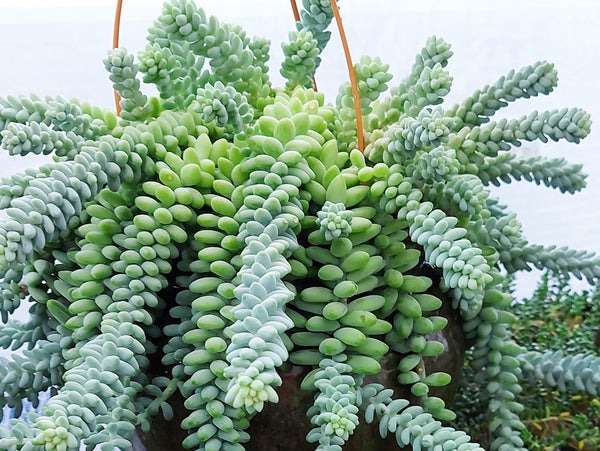The Donkey Tail Succulent, also known as Sedum morganianum, is a popular and unique plant that belongs to the Crassulaceae family. This plant is native to Mexico and is characterized by its long, trailing stems covered in plump, fleshy leaves. It is a favorite among gardeners and succulent enthusiasts due to its interesting appearance and low maintenance requirements.The Donkey Tail Succulent has a rich history and has been cultivated for centuries. It was first discovered in Mexico in the 19th century and was later introduced to Europe and other parts of the world. Its unique trailing stems and delicate leaves make it a popular choice for hanging baskets and containers, adding a touch of elegance to any space.
In gardening, the Donkey Tail Succulent is highly valued for its ability to thrive in dry conditions and its resilience to neglect. It is a great choice for beginners or those who have limited time to care for their plants. With proper care, this succulent can live for many years, bringing beauty and charm to any garden or indoor space.
Understanding the Characteristics of Donkey Tail Succulent
The Donkey Tail Succulent is known for its distinctive physical appearance. It has long, trailing stems that can reach up to 2 feet in length. These stems are covered in thick, fleshy leaves that resemble the tail of a donkey, hence its common name. The leaves are blue-green in color and have a powdery coating, giving them a unique texture.
This succulent has a trailing growth habit, making it perfect for hanging baskets or cascading over the edges of containers. It can also be grown as ground cover or used in rock gardens. The Donkey Tail Succulent can grow up to 6 inches tall and spread up to 3 feet wide, creating a lush and full appearance.
The leaves of the Donkey Tail Succulent are cylindrical in shape and can grow up to 2 inches long. They are tightly packed along the stems, giving the plant a dense and compact look. In the summer, the plant produces small, star-shaped flowers in shades of pink or red. While the flowers are not the main attraction of this succulent, they add a pop of color to the overall appearance.
One of the unique features of the Donkey Tail Succulent is its ability to propagate easily. The leaves of this plant can be easily removed and rooted to create new plants. This makes it a great choice for those who want to expand their succulent collection or share plants with friends and family.
Choosing the Right Soil and Pot for Donkey Tail Succulent
The Donkey Tail Succulent has specific soil requirements to ensure its optimal growth and health. It prefers well-draining soil that allows excess water to flow out easily. A mixture of cactus potting mix and perlite or pumice is ideal for this succulent. This type of soil provides good drainage while retaining enough moisture for the plant’s needs.
When it comes to choosing a pot for the Donkey Tail Succulent, it is important to consider its trailing growth habit. Hanging baskets or containers with drainage holes are recommended to prevent water from pooling at the bottom and causing root rot. The size of the pot should be proportionate to the size of the plant, allowing enough room for growth without overwhelming it.
When potting the Donkey Tail Succulent, it is important to handle it with care due to its delicate leaves. Gently remove the plant from its nursery pot and loosen the roots if they are tightly packed. Place the plant in the center of the new pot and fill in with soil, making sure not to cover the leaves or crown of the plant. Lightly press down on the soil to secure the plant in place.
Watering and Fertilizing Donkey Tail Succulent
The Donkey Tail Succulent is a drought-tolerant plant that thrives in dry conditions. It is important to water this succulent sparingly to prevent overwatering, which can lead to root rot. Allow the soil to dry out completely between waterings and then water thoroughly, ensuring that excess water drains out of the pot.
During the summer months, when the plant is actively growing, it may require more frequent watering. However, it is still important to check the moisture level of the soil before watering to avoid overwatering. In the winter, when the plant is dormant, reduce watering to once every few weeks or when the soil is completely dry.
Fertilizing the Donkey Tail Succulent is not necessary but can help promote healthy growth and vibrant foliage. Use a balanced liquid fertilizer diluted to half strength and apply it once a month during the growing season. Be careful not to over-fertilize, as this can lead to excessive growth and weak stems.
To maintain healthy growth, it is important to provide proper care for the Donkey Tail Succulent. This includes regular monitoring of watering needs, adjusting watering frequency based on environmental conditions, and providing adequate light and nutrients.
Lighting Requirements for Donkey Tail Succulent
The Donkey Tail Succulent thrives in bright, indirect light. It prefers at least 6 hours of sunlight per day but can tolerate partial shade. Placing the plant near a south or west-facing window is ideal for providing it with enough light. If growing indoors, consider using artificial grow lights to supplement natural light.
Direct sunlight can cause sunburn on the leaves of the Donkey Tail Succulent, so it is important to protect it from intense afternoon sun. If growing outdoors, provide some shade during the hottest part of the day or move the plant to a location with filtered sunlight.
During the winter months, when the sunlight is less intense, it may be necessary to move the Donkey Tail Succulent closer to a window or provide additional artificial light. Lack of light can cause the plant to become leggy and lose its compact shape.
Propagation Techniques for Donkey Tail Succulent
The Donkey Tail Succulent is a relatively easy plant to propagate. It can be propagated through stem cuttings or leaf cuttings. Stem cuttings are the most common method and yield faster results.
To propagate through stem cuttings, select a healthy stem and use a clean, sharp knife or scissors to cut it just below a leaf node. Allow the cutting to dry for a few days until the cut end forms a callus. Once the callus has formed, place the cutting in well-draining soil and water sparingly. Keep the soil slightly moist until roots develop, which usually takes a few weeks.
Leaf cuttings can also be used to propagate the Donkey Tail Succulent. Gently remove a leaf from the plant and allow it to dry for a few days until a callus forms on the cut end. Place the leaf on top of well-draining soil and mist lightly with water. Keep the soil slightly moist until new roots and baby plants emerge from the base of the leaf.
When propagating the Donkey Tail Succulent, it is important to use clean tools and containers to prevent the spread of diseases. It is also important to provide proper care for the new plants, including adequate light, water, and nutrients.
Common Pests and Diseases that Affect Donkey Tail Succulent
The Donkey Tail Succulent is generally resistant to pests and diseases, but it can still be affected by certain issues. The most common pests that affect this succulent are mealybugs and aphids. These pests feed on the sap of the plant, causing damage to the leaves and stems. To prevent and treat pest infestations, regularly inspect the plant for signs of pests and use organic insecticidal soap or neem oil to control them.
Overwatering can lead to root rot, which is a common issue for the Donkey Tail Succulent. To prevent root rot, ensure that the soil is well-draining and allow it to dry out completely between waterings. If root rot occurs, remove the affected parts of the plant and repot it in fresh, well-draining soil.
Another common issue for this succulent is leaf drop. Leaf drop can be caused by overwatering, underwatering, or sudden changes in environmental conditions. To prevent leaf drop, provide consistent care for the plant and avoid drastic changes in watering or lighting.
Tips for Pruning and Shaping Donkey Tail Succulent
Pruning the Donkey Tail Succulent is not necessary for its overall health but can help maintain its shape and size. Pruning is often done to remove dead or damaged leaves, promote branching, or control the growth of the plant.
When pruning the Donkey Tail Succulent, use clean, sharp scissors or pruning shears to make clean cuts. Remove any dead or damaged leaves by cutting them off at the base of the stem. To promote branching, cut back the stems just above a leaf node. This will encourage new growth and create a fuller appearance.
To control the growth of the plant, trim back any excessively long stems or remove stems that are growing in unwanted directions. This will help maintain the desired shape and size of the Donkey Tail Succulent.
After pruning, it is important to provide proper care for the plant to ensure its quick recovery. This includes providing adequate light, water, and nutrients, as well as monitoring for any signs of stress or disease.
Creative Ways to Display Donkey Tail Succulent
The Donkey Tail Succulent is a versatile plant that can be displayed in various creative ways. Its trailing growth habit makes it perfect for hanging baskets or containers, where it can cascade over the edges and create a stunning display. It can also be grown as ground cover or used in rock gardens to add texture and interest.
Indoors, the Donkey Tail Succulent can be displayed in decorative pots or terrariums. It can be placed on windowsills, shelves, or tabletops to add a touch of greenery to any space. Grouping multiple plants together can create a lush and vibrant display.
Outdoors, the Donkey Tail Succulent can be displayed in hanging baskets, window boxes, or wall planters. It can also be planted in the ground and used as a border or filler plant. When planting in the ground, make sure to provide enough space for the plant to spread and grow.
When creating a unique display with the Donkey Tail Succulent, consider combining it with other succulents or plants with contrasting colors and textures. This will create a visually appealing arrangement that will catch the eye.
Conclusion: Enjoying the Beauty of Donkey Tail Succulent
In conclusion, the Donkey Tail Succulent is a beautiful and unique plant that is highly valued in gardening. Its trailing stems and fleshy leaves make it a favorite among succulent enthusiasts, while its low maintenance requirements make it suitable for beginners.
Understanding the characteristics of the Donkey Tail Succulent, such as its physical appearance and growth habit, is important for providing proper care. Choosing the right soil and pot, watering and fertilizing correctly, providing adequate lighting, and knowing how to propagate and prune the plant are all essential for its optimal growth and health.
Displaying the Donkey Tail Succulent in creative ways allows us to appreciate its beauty and enhance our living spaces. Whether indoors or outdoors, this succulent adds a touch of elegance and charm to any environment.
In conclusion, the Donkey Tail Succulent is a versatile and resilient plant that brings beauty and joy to any garden or indoor space. With proper care and attention, this succulent can thrive for many years, providing a stunning display of trailing stems and fleshy leaves. So why not add a Donkey Tail Succulent to your collection and enjoy its unique beauty?
If you’re a fan of donkey tail succulents, you might also be interested in unlocking the meaning of angel number 2525. This comprehensive guide explores the message of creativity, self-expression, and abundance that this angel number brings. Click here to read more about it:

















Add Comment